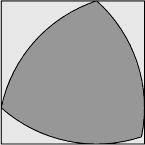Reuleaux triangle
The Reuleaux triangle is the simplest noncircular curve of constant width. Also known as the Reuleaux wheel, it is named after the German engineer and mathematician Franz Reuleaux (1829–1905). Although it was known to earlier mathematicians, Reuleaux was the first to show its constant-width properties.
 |
To form a Reuleaux triangle, take the three points at the corners of an equilateral triangle and connect each pair of points by a circular arc centered at the remaining point. The ratio of the circumference to the width of the triangle is, remarkably, pi.
By rotating the centroid of a Reuleaux triangle appropriately, the figure can be made to trace out a square, perfect except for slightly rounded corners. This idea has formed the basis of a drill that will carve out squares, first patented by Harry Watts in 1914. Bits for square, pentagonal, hexagonal, and octagonal holes are still sold by the Watts Brothers Tool Works in Wilmerding, Pennsylvania. The actual drill bit for the square is a Reuleaux triangle made concave in three spots to allow for unobstructed corner-cutting and the discharge of shavings. The Reuleaux triangle may also form the shape of the piston in a rotary, or Wankel, engine, in which gasoline burns in crescent-shaped chambers, turning a rotating piston that drives an axle through its center.
Reuleaux polytope
The Reuleaux polytope is a convex body in the plane or in higher dimensions which, like the Reuleaux triangle, consists of pieces of round spheres, each centered at one of the corners of the convex body.

